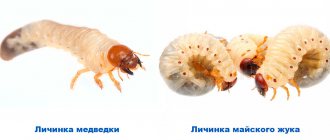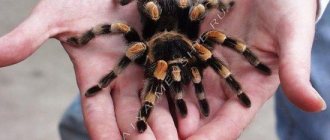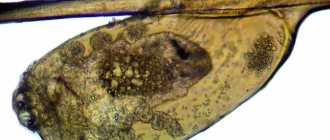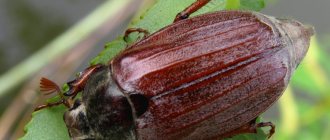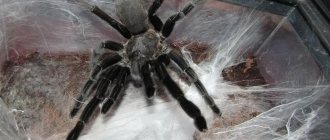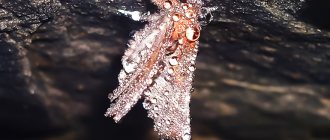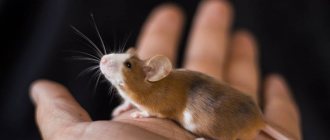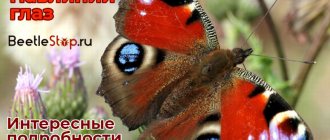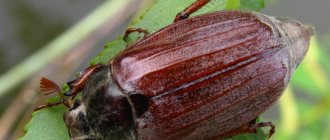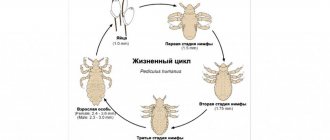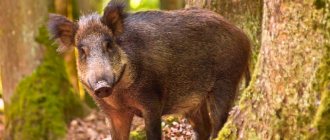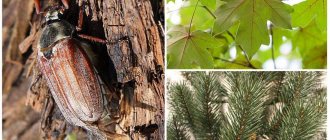Almost every person living in central Russia or in its European part has at least once encountered such a phenomenon as an invasion of cockchafers. Usually for children this event is of an entertaining nature. Large and loudly buzzing insects tend to fly around street lamps at dusk. Knocking on the glass and getting burned, they fall down and fall into the hands of young naturalists. But few people have thought about what cockchafers eat.
Important!
In addition to being fun for children, these insects are pests of tree crowns. Sometimes their invasion leaves behind serious and irreparable consequences. Trees lose part of their crown, causing photosynthesis processes to be disrupted and the plant cannot receive adequate nutrition. This factor leads to a decrease in yield or even the death of a flora representative.
Description and features of the insect
We came across an average specimen about 3 cm in length. Fan-shaped antennae and large bulging eyes gave the beetle a touching expression. Without a magnifying glass, numerous white hairs were visible on the head, chest and hard red-brown elytra. The mandible and lower jaw with olfactory palps were examined in the picture in the encyclopedia, because it was not possible to fix the beetle for detailed study. The insect was friendly, did not hide or bite, and moved quickly and purposefully. With the help of three pairs of legs with strong curved claws, our guest climbed his bare arm as easily as he climbed clothing.
The cockchafer flies, violating all the laws of aerodynamics. But he doesn’t know this and continues to fly. Photo: naturephotoportal.com
In the process of searching for information, we learned a very interesting fact: the May Khrushchev turned out to be a “malicious violator” of the laws of aerodynamics. From the point of view of scientists, thin narrow wings cannot lift the weight of his body: their design is unsuccessful, and the muscles are not sufficiently developed. Khrushchevs who disagree with the criticism fly carefree, reaching speeds of up to 3 km/h. The taking off beetle takes in air into hidden cavities and becomes three times lighter, turning into something between an airship and a helicopter.
What do the cockchafer and its larvae eat in nature?
First of all, the children and I found out what kind of food the insect prefers in its natural environment.
During the first summer, the furrow beetle - the larva of the cockchafer - feeds on the thin roots of herbaceous plants. The next season, she chooses coarser food, gnawing young shoots of the underground part of trees and shrubs. After another year, her jaws can cope with absolutely all the “delicacies” underground. If a beetle larva is lucky enough to “settle” in a garden or field, it will gnaw on any root crops: potatoes, carrots, beets and dahlia bulbs. This malicious pest often spoils the crops in our area.
This is interesting! The importation of beetroot into North America is strictly prohibited by law. Here the cockchafer has no natural enemies. A voracious insect can cause an environmental disaster.
The adult cockchafer feeds on solid plant food and destroys large quantities of young greenery, flowers and ovaries of all plants in the surrounding area. During the years of mass flight, completely eaten branches can be seen on trees “captured” by Khrushchev. Coniferous and deciduous crops, but especially fruit crops, suffer from pest attacks.
Fighting Khrushchev with folk remedies and preventing the pest
As a folk remedy for combating cockchafer larvae, one can consider growing lupine on the plot for its further use as green manure. Weeds do not grow on the crops of this crop, and the larvae of the cockchafer have to feed on the roots of lupine, which is poisonous to them.
As a preventive measure against beetles, in the spring you can water the soil around strawberries or in tree trunks with a solution of 10-20 ml of ammonia in 10 liters of water. Or dissolve 200 g of coarse salt and 2 tablespoons of ammonia in a bucket of water and pour this mixture over the beds. Digging up the area in the spring and loosening the soil between rows of potatoes during May and throughout the summer can help in the fight against larvae - at this time the beetles lay eggs, molt and pupate.
A solution of 5 g of potassium permanganate in 10 liters of water, which is used to water the soil around the potato bushes, can protect your crop from beetle larvae, and if you have chickens, drive them out into the potato field - they do an excellent job with the Maybug larvae.
Mole cricket: how to fight, remedies and preparations Mole cricket in the garden: how to fight, how to treat it, how to get rid of it forever
After this article they usually read
Add a comment
Khrushchev diet at home
My fishermen friends told me about what the furrowfish eats at home. They keep the larvae in buckets of soil and use them as bait for large fish. Insects are not picky; they eat any solid plant food: pieces of root vegetables, chopped greens.
The children kept the caught beetle for two days. Birch, linden and currant branches with soft leaves were placed in a plastic bottle with holes for ventilation. The guest ate only freshly picked greens.
Good to know! The “gourmet” will be pleased if the leaves turn out to be moist and soft, not yet fully blossomed.
On the third day, the insect clearly weakened: the lack of movement and sun had an effect. I had to release Khrushchev into freedom.
Description of the insect
The second name for the May beetle is Khrushchev . He belongs to the representatives of the Melolonta family. The insect is native to Asian and Northern European countries and is most often found in forests, steppes and areas where garden trees and shrubs grow. Such places for living were not chosen in vain: young green foliage is the Khrushchev’s favorite delicacy. It eats it en masse and causes damage to all plantings.
There are two varieties of May beetles. It is very easy to distinguish them from each other, since they have different bright colors:
- the red beetle has reddish paws and back, is most often found in the northern regions, loves open spaces without shade;
- The black beetle has dark legs and back, is common in the southern regions, prefers to feed in shady places.
What do cockchafers eat?
The diet of adult beetles and their larvae is very different. This is due to the different stages of development of their mouth opening and the ability to digest food.
What do adult beetles eat?
May beetles are capable of eating a lot of food at one time.
Their favorite food is young shoots of trees and shrubs. A large family of beetles can easily destroy all the greenery in a summer cottage. Most often, their prey is leaves, but sometimes they are not averse to feasting on thin bark and buds. The active period for Khrushchev begins in mid-spring. At this time, the following plants may be attacked:
- maple;
- birch;
- oak;
- peach and apricot trees;
- willow;
- pear and apple;
- poplar;
- coniferous trees: spruce, pine.
What do larvae eat?
Khrushchev larvae are a dangerous enemy of the gardener. They can cause irreparable damage to plants for many years, staying in the ground and feeding on roots. It eats a lot, and you can only get rid of it by digging it out of the ground.
The larvae are difficult to catch; they are able to move quickly in the upper layers of the soil, and in the winter they go deeper - up to half a meter. When it's warm outside, they prefer to live in the root system of trees and flowers, feeding on whatever they can get their hands on.
The following plants are most often affected by larvae:
- vegetables - potatoes, carrots, beets;
- flowers - dahlias, peonies;
- berries - strawberries, currants, strawberries;
- trees - pear, apple, cherry.
Young bushes and trees are of particular interest to the pest. Its gluttony is amazing: literally in a day, one individual is capable of destroying the root of an adult tree.
Diet of adults and larvae
Based on what the cockchafer and its voracious larva feed on, one can determine the extent of potential harmfulness.
Adult adults first attack oak and birch groves, gnaw the inflorescences of fruit trees (plum, cherry), and damage walnuts, hazelnuts, and apple trees. In summer years, any plantings are attacked - linden, alder, poplar, beech, acacia. The exception for Western beetles is coniferous plantings, but they are preferred by the eastern variety of the insect.
What plant organs are damaged by cockchafers? Since the summer falls in May, young apical shoots, catkins of alder, birch, pine, spruce, inflorescences and ovaries of fruit and berry crops suffer the most. In addition to their favorite plums and cherries, grapes, honeysuckle, hazel, and rose hips also come into the Khrushchev's field of vision. Infestations of beetles cause great damage to nurseries, since they are able to gnaw and completely destroy young seedlings.
The larva is even more omnivorous - it gnaws at any roots encountered along the way, be it young seedlings, herbaceous crops, cereals, root crops, seedlings of garden crops. Moreover, if the active period of Khrushchev does not exceed 1.5 months, then Khrobak harms all summer.
I wonder if the cockchafer can be beneficial? As far as we know, the merits of the Khrushchev, or rather its larvae, were appreciated only by avid fishermen. Bream, chub, ide, and perch bite well on this bait. It is not difficult to dig up larvae in the spring - they rise to the top layer of soil, hide in compost and humus.
Interesting facts about the life of the cockchafer:
Life of the cockchafer at home
The cockchafer is far from the most popular pet.
Most often, an inquisitive child can bring it into the house to watch the insect and feed it. Such a neighborhood is very dangerous for summer residents, because the beetle can quickly move into the garden and cause great harm to all plants. If you nevertheless decide to have such an unusual pet, you need to place it in a pot of soil. You need to feed it the freshest leaves from bushes and trees. He will not eat dry leaves.
To prevent beetles from breeding in your garden, you can hang several birdhouses on the trees. Birds will catch insects and protect trees from their harm.
Who eats Khrushchev?
May beetles themselves are a favorite treat for domestic birds : chickens, geese and turkeys. Wild forest animals, such as hedgehogs or moles, also love to eat such food. Birds do not fly past the insect, catch it and eat it, thereby protecting garden plants.
Experienced fishermen catch beetles and use them as bait for fishing. River fish bite well on this bait.
The flight of the cockchafer is one of the first signs of the onset of spring warmth. Watching them is a pleasure for children and adults. But we must remember that just a few beetleworms can leave a gardener without a harvest of his favorite vegetables and fruits. Therefore, you need to try to control their reproduction in your summer cottage, especially when getting such a pet at home.
Lifestyle and habitat
Khrushchi are typical representatives of the Melolont genus, living in Asia and the northern part of Europe. The life cycle of this arthropod averages 3 years, during which it undergoes a series of transformations.
- In the first year of life, a larva hatches from an egg laid by an adult female. It originates in the upper layers of the soil and develops throughout the warm season. To survive the winter, the caterpillar that has formed over the summer burrows deeper into the soil and waits out the cold. In the first year of its existence, the cockchafer larva feeds on the small roots of grasses or cultivated plants.
- The second year of Khrushchev development also takes place underground. But the individual has already reached a more impressive size (up to 5 centimeters) and has a good appetite. In the second year of life, it is already able to eat the root system of an adult tree, thereby causing significant harm to the plants.
- During the third year, the large caterpillar turns into a beetle, moving to the final stage of its life cycle - the adult. The adult insect remains underground for some time and only comes to the surface to mate. In dry and warm weather, cockchafers fly around trees and over meadows, looking for a mate. The male dies soon after the mating season ends, and the female dies after she lays eggs in the ground.
The beetle in the adult stage under natural conditions eats succulent leaves, shoots, and buds of trees and shrubs growing in temperate climatic zones. The diet of arthropods also includes cultivated plant varieties, for example, apple trees, grapes, pears or plums.
Due to the damage that pests cause to agriculture, chafers and their larvae are actively exterminated, artificially reducing the population.
Life cycle
The full life cycle of the cockchafer takes from 3 to 5 years, depending on the climate. For almost all five years, the cockchafer lives underground. The cockchafer flies for a relatively short time, only 30-40 days.
Reproduction
1-3 weeks after emerging from the pupa, the female cockchafer is ready to reproduce. After mating, she soon lays eggs, burrowing into the ground to a depth of about 10 cm. She then feeds, searches for a male and lays eggs again. The total number of eggs is about 70 pieces. The female performs such cycles up to four times, spending a lot of energy. After the last ovipositor, the female dies right in the soil.
Egg
The egg is off-white, 2 mm wide and 3 mm long. It is soft at first and hardens later. The egg develops within 24-35 days. Under unfavorable conditions, development can take up to 50 days.
Larva
The larva of the cockchafer is thick, light-colored, curved. The head is round and light yellow or brown in color. Equipped with 3 pairs of small tenacious paws. The last instar larva reaches a length of 45-65 mm.
Doll
The cockchafer pupa is located in the ground at a shallow depth, in a cradle. The shape resembles an adult beetle with short wings and a head tucked under the chest, the color is yellowish. Its length is 25 mm, width is 18 mm. The pupal phase lasts from 2 weeks to a month. The pupa appears in late July - early August at a depth of 20-40 cm.
Stages of development
- During the first summer, the larva feeds on humus and grass roots. In winter, the larvae climb to a depth of one and a half meters, and in the spring they move again closer to the roots.
- In the second year, the larvae feed on the roots of young trees.
- In the third year, the larvae reach a size of 5-6 centimeters and are able to gnaw the root of even an adult tree.
- In the fourth year of life, the larva turns into a pupa, and after a month or two - into a beetle.
The beetles hatched at the end of the season go into suspended animation and remain in the cradle until spring. And closer to May, when it gets warm and leaves appear on the trees, May beetles begin their flights.
What do cockchafers eat in nature?
The diet of cockchafers in their natural habitat is quite diverse. It depends on what trees or shrubs grow nearby.
Insect larvae significantly damage the root system of the tree, and also eat any root crops: carrots, beets, potatoes. Adults in the imago development stage destroy shoots, buds and young leaves.
This leads to the fact that the plant loses its ability to photosynthesize and suffers for a long time due to the damage received.
The following tree species are suitable for feeding beetles:
- Garden crops: apple, pear, plum, quince, cherry.
- Deciduous trees: linden, alder, birch, maple, aspen, willow, poplar.
- Coniferous species: pine, spruce.
Not only on trees, but also near bushes you can find flocks of cockchafers. Rose hips, currants, and gooseberries are excellent food for these insects.
Lifespan
The development of the cockchafer is long, but its full existence is short. The total life cycle reaches 5 years, of which only one is summer (about 2 months), the beetles are active.
Let's take a closer look at the life stages of a beetle:
- 30 - 40 days - egg stage;
- 3 − 4 years - larval stage;
- 1.5 − 2 months. - pupal stage;
- imago (full-fledged beetle) - about a year, of which the insect is awake for only 5 - 7 weeks.
During this entire cycle, the family living in the roots of the plant can completely destroy the adult tree. Therefore, people actively use chemicals to combat Khrushchev.
Diet of insects at home
In their natural habitat, such insects are not picky in their choice of food and can cause significant damage to plants. What is most often found at home is an adult that has transformed from a larva into a beetle. It is of interest to children and amateur naturalists who are trying to keep a similar buzzing specimen as a pet.
In captivity, Khrushchev eats the following delicacies:
- Vegetables: potatoes, carrots, cucumber.
- Young shoots and fresh leaves of trees.
As practice shows, dry and limp treats are not very attractive to insects. Only succulent shoots and leaves are suitable for chafer beetles to eat.
It should be borne in mind that such individuals in the imago stage are not the most suitable option for a pet. Both in the natural environment and in captivity, it does not exist for long. After the insect mates and lays eggs in the ground, it dies. Being a larva or pupa, a beetle can live in captivity for quite a long time, but only if all conditions are created for this.
How to deal with pests?
Gardeners use comprehensive control measures. In late spring and summer, the larvae crawl closer to warmth, and at this time they dig the ground for planting. It is easy to find them on the surface and destroy them, the number is significantly reduced. Khrushchev do not like nitrogen; experienced gardeners recommend planting white clover around the perimeter of the territory, which makes nitrogen available to the soil.
Insects do not like the smells of lupine, elderberry and cruciferous vegetables (various varieties of cabbage). Attract starlings to the area and feed hedgehogs. Treat the ground with a solution of onion peels. Add husks 1/3 full into the bucket, cover with warm water and leave for 5 days. After this, dilute the solution with water 1:1 and water the soil.
Use industrial insecticides between the rows: Antikhrushch, Nemabakt, Bazudin, Zemlin. They rid greens of pests and are also safe for pets and humans.
Source: adella.ru
How do you like the article?
What do beetles drink in nature and in captivity?
In its natural habitat, the beetle is surrounded by a large amount of moisture. It drinks dew from grass or trees, and also finds moisture after rain in curled leaves. Since cockchafers feed exclusively on young and succulent leaves, they obtain the bulk of water from food, and in case of lack of moisture, they replenish the deficit with dew drops. In the larval state, the insect receives liquid from juicy root crops, and during periods of drought it burrows deeper into the ground.
At home, before feeding the insect with young shoots, they need to be lightly irrigated. This way, the beetle will be able to independently replenish its moisture supply in case of dehydration. It is considered inappropriate to provide it with water separately, since the beetle requires a minimum amount of it, and in a deep container it can drown.
Description of the pest
May beetle (Melolontha hippocastani) is one of 24 representatives of the genus Melolontha, belongs to the class Insects, species Arthropods. They are most often found in Asia, Northern and Central Europe, preferring to live in forests, forest-steppes, fruit and berry plantations and shrubs. Here they feed on young leaves, causing enormous damage to all plants.
Khrushchev is characterized by color dimorphism, which means it is divided into 2 color varieties:
- red with red legs and dorsum (rex), lives in the northern regions, and prefers to live in open areas, without shade;
- black with black legs and foreback (nigripes), which lives in the southern area in shaded places.
In the middle zone, both species are equally common.
What do cockchafers eat?
The food of the cockchafer depends on its stage of development, because in different periods its oral organ is developed differently. This determines his taste preferences.
What do adults eat?
These insects appear with the simultaneous establishment of constant warm weather - at the end of April and in May. And it’s no secret that during this period the cockchafer eats all the young ovaries, flowers and leaves of forests, parks and fruit and berry trees.
Those who suffer most from it are:
- from parklands: birches, maples, lindens, willows, poplars and oaks;
- garden trees: apple trees, plums, apricots, cherries, peaches, pears;
- forest plantations: spruce and pine.
What do larvae eat?
But if an adult insect actively feeds during the period of reproduction and growth - for 1-1.5 months, then the larva of the cockchafer is much more dangerous and voracious.
She goes through 6 stages of growing up in the ground and lives there for up to 4 years. It constantly migrates in the horizontal layers of the soil, only burrowing to a depth of 50 cm in the winter. During the warm period of the year, the larva is always in the root layer of the earth, gnawing everything that comes in its way. What causes the most damage is:
- tuberous vegetable and ornamental plants, such as beets, carrots, potatoes, dahlias, etc.;
- roots of strawberries, strawberries, all types of black and red currants;
- the root system of apple and cherry trees, under which they can be found most often;
- forest and park plantings, especially young ones with delicate roots.
Diet of adults and larvae
Based on what the cockchafer and its voracious larva feed on, one can determine the extent of potential harmfulness.
Adult adults first attack oak and birch groves, gnaw the inflorescences of fruit trees (plum, cherry), and damage walnuts, hazelnuts, and apple trees. In summer years, any plantings are attacked - linden, alder, poplar, beech, acacia. The exception for Western beetles is coniferous plantings, but they are preferred by the eastern variety of the insect.
What plant organs are damaged by cockchafers? Since the summer falls in May, young apical shoots, catkins of alder, birch, pine, spruce, inflorescences and ovaries of fruit and berry crops suffer the most. In addition to their favorite plums and cherries, grapes, honeysuckle, hazel, and rose hips also come into the Khrushchev's field of vision. Infestations of beetles cause great damage to nurseries, since they are able to gnaw and completely destroy young seedlings.
The larva is even more omnivorous - it gnaws at any roots encountered along the way, be it young seedlings, herbaceous crops, cereals, root crops, seedlings of garden crops. Moreover, if the active period of Khrushchev does not exceed 1.5 months, then Khrobak harms all summer.
I wonder if the cockchafer can be beneficial? As far as we know, the merits of the Khrushchev, or rather its larvae, were appreciated only by avid fishermen. Bream, chub, ide, and perch bite well on this bait. It is not difficult to dig up larvae in the spring - they rise to the top layer of soil, hide in compost and humus.
Interesting facts about the life of the cockchafer:
Can Khrushchev live at home?
At home, beetles can be found quite rarely, but it is possible for the larvae to be introduced into the soil that was taken from the garden or vegetable garden for planting. What chafers eat at home will depend on what pot you poured the soil with the pest into.
If you or your child brought the Mayweed into your home as a new pet, then it will happily live and eat the fresh leaves of any fruit trees. But it’s better not to start one, since there is a high risk of laying eggs in the soil of your house plants, then they will all die.
Excursion into history
For most of our contemporaries, the cockchafer evokes sympathy, but man's attitude towards this insect has not always been good-natured. And all because of the food preferences of the beetle and its larvae.
France and Germany were shuddered by massive outbreaks of beetleworm reproduction, occurring every 4 years, and especially intense - once every 30 years. There were so many insects that in June the forests were completely eaten away, hungry beetles even flattened the bark on young shoots. The beetles, usually picky eaters, attacked not only deciduous trees, but also conifers, leaving pines and spruces without flower buds. On a completely windless day, the grass in the meadows shuddered and swayed as if on its own - these, invisible underground, were myriads of larvae devouring the roots, greedily tugging at them with their powerful jaws...
The cockchafer terrorized Europe throughout the history of agriculture, from the Middle Ages until the 50s of the 20th century. All sorts of methods were tried, but to no avail. Only the invention of pesticides put an end to the rampant pest.
The chronicles preserve interesting and even funny facts regarding this insect. Thus, in 1320, a trial of the cockchafer was held in Avignon (Provence, France), which sentenced the beetles to exile. The Khrushchevs were ordered to leave the country within a few days. Since they did not even think to carry out the order, they were excommunicated from the church.
In France, in the 18th-19th centuries, a popular dessert was May beetle larvae in honey. This dish supposedly had miraculous powers (the rumor was started by clever gypsies who bought worms for next to nothing from peasants and made money by selling them to aristocrats). To remove the blackness in the abdomen of the larva and give it an ivory tint, it was kept for a month in sawdust soaked in whey.
Who eats them: the main pests of cockchafers
The main lovers of cockchafers are domestic birds: chickens, ducks, turkeys, etc., and among wild animals - lizards, snakes, hedgehogs, moles. And not a single bird will just fly over a tree where it notices a May beetle, but will definitely eat it.
The fisherman who took cockchafers with him as bait can also boast of an excellent catch. Fish are very fond of these insects for their size and taste.
Although the appearance of cockchafers means the onset of warmth and spring, and observing their behavior in nature can be very interesting, we should not forget that they are still real pests of our gardens and vegetable gardens, and their excessive reproduction threatens the death of plants.
Popular message topics
- City of Prokopyevsk
Prokopyevsk is one of the oldest cities in the Kemerovo region. It is home to about 196,000 thousand people, and it can also be added that the city was the center of coal mining in the country, and had as many as 16 coal mines, - Cell structure and division
A cell is an elementary part of an organism that can itself exist, self-reproduce and develop. It is a fundamental element of all living things, both organisms and plants. Cells can be independent organisms. - Gladiolus
It is impossible to imagine the world famous school holiday Day of Knowledge without bouquets of flowers. Many of them look spectacular thanks to the gladioli they contain. Translated from Latin, this word means sword.
